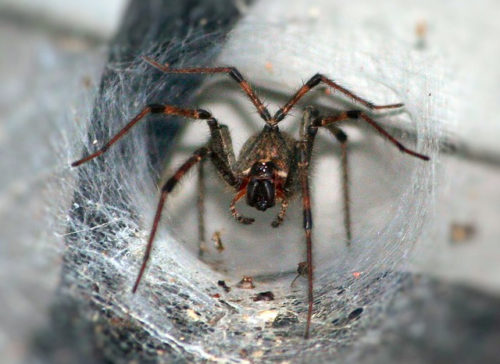Spiders are very common in the North West and even the most harmless of them can strike fear in the hearts of many. Fortunately, most spiders in the North West do not pose a threat to humans. Still, it is important to identify spiders that are lurking in and around your home so you can understand the extent of the problem, and know if they need to be removed right away. Listed below are some of the most common venomous spiders in Washington, Idaho, and Oregon, where you will find them, and if you should be concerned if you find them in or near your home.
Hobo Spiders
Hobo spiders are significantly larger than other types of spiders, but they typically only come out at night to hunt for prey. When found by humans, they are typically in bathtubs or found crawling along the floor. Contrary to popular belief, they are not more aggressive than other spiders. Although venomous, in the North West and throughout parts of America, it has been extensively debated how dangerous these spiders are. In Europe, hobo spiders are considered harmless. Regardless, the Oregon Department of Agriculture says that hobo spider bites are very rare in the North West.
Wolf Spiders
Wolf spiders got their name because instead of spinning webs and waiting for their prey, they hunt in packs, like wolves. After a female spider’s eggs hatch, they will climb onto her abdomen and travel with her wherever she goes. Just prior to molting, these small spiders will leave the abdomen and start their adult lives. Wolf spiders are venomous but even so, they pose little danger to humans. They are not particularly aggressive, only biting when they feel threatened. Humans that are bitten will typically only experience some redness and swelling in the area bitten.
Zebra Jumper Spiders
Zebra jumper spiders prefer to stay outside, usually nears doors and windows in sunny areas of the home. When it is time to lay their eggs, the females will typically deposit the egg sacs under window sills or eaves where they are offered some protection. Zebra jumper spiders do produce venom, which they use to stun their prey. However, because they are so small, this venom is not particularly dangerous to humans.
Cross Orb Weaver Spiders
Cross orb weaver spiders are most noticeable in the late summer and early fall, as the spiders mature and start to build their large webs. Cross orb-weaver spiders generally stay outside, where they can catch prey such as flies and other flying insects. Although these spiders can grow to a significant size and do produce venom, for humans, they pose little risk. Cross orb weaver spiders are not aggressive and will not generally bite unless they are handled or otherwise feel threatened. Still, even when a human is bit, the damage is not much more than a bee sting, unless a person is particularly allergic to their venom.
Yellow Sac Spiders
Like so many types of spiders, the yellow sac spider came to America from Europe. They are mainly active at night and are typically only seen in the spring and summer months. Instead of spinning webs to catch their prey, they chase insects found on ceilings and walls within a home, which is where homeowners are most likely to find them. Due to the fact that they are nocturnal, yellow sac spiders retreat into silk sacs they have spun during the day. Usually, these are found in the corners of walls and ceilings, near their hunting grounds.
Yellow sac spiders do produce venom, but it is not enough to kill humans. The scariest part of these spider bites is the fact that the venom contains cytotoxin, which can cause necrosis within the wound. Rotting flesh can result from a yellow sac spider bite, but this is quite rare. In most cases, a person will feel mild symptoms such as a headache or nausea. In the most severe cases, these bites can result in anaphylactic shock if the individual is allergic to the venom. Still, in most cases, a bite from a yellow sac spider will only result in swelling, redness, and mild pain.
Black Widow Spiders
Even the name ‘black widow spider’ is enough for many people to imagine the most poisonous type of spider. Although the black widow is not the most poisonous in the world, people should never try to remove these spiders on their own, as they are quite dangerous. In fact, they are the most dangerous type of spider found in the North West. The venom of a black widow spider affects the nervous system, which can result in symptoms such as nausea, abdominal cramps. perspiration, labored breathing, tremors, and restlessness. Elderly individuals, infants, and other people with compromised immune systems are most at risk of black widow spider bites.
Black widow spiders are quite large, and their bodies and legs are both completely black, with the exception of females. Female black widow spiders are especially easy to identify, as they have a red hourglass shape on their abdomen. Black widow spiders, unfortunately, are often found around homes in areas such as crawlspaces, in wood piles, under eaves, and around the foundation of structures.
Brown Recluse Spiders
Brown recluse spiders are very dangerous and can cause a form of necrosis, just like yellow sac spiders. However, the bite of a brown recluse spider is much more potent and causes much more serious symptoms. Many people think that brown recluse spiders are commonly found in the North West, but this is not actually true. When people believe they have seen brown recluse spiders in the North West, it is typically a case of mistaken identity.
Let Us Help You with Venomous Spiders in Oregon, Idaho, and Washington
Most of the spiders found in the North West do not pose a risk to humans, but that does not mean that you want an infestation in or around your home. If you are trying to get rid of venomous spiders in Idaho, Washington, or Oregon, our spider control specialists at Pointe Pest Control are here to help. We will identify the type of spider you are dealing with, and effectively eliminate the problem so you can enjoy your home once again. Call us today at (866) 633-1573 to request a quote.




